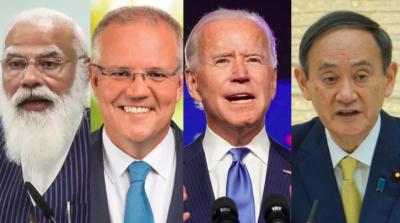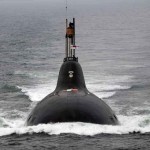
Plenty has been written about future of the Quad after the First Quad Leaders Virtual Summit on March 12, 2021. There is divergence of views whether the Quad can emerge as a strategic counter to China’s blatant aggressive moves or not. Some say it can hardly match up to the aggressive antics of China in absence of a joint Quad strategy and inhibitions of individual Quad members how to deal with China. Others feel that policy makers of Quad nations have moved swiftly in the maritime domain to signal their combined professional capability and political resolve to uphold the sanctity of international law.
The above Quad leaders summit was followed by the five nation France-led ‘La Perouse’ naval exercise held in the Bay of Bengal from April 5 to April 7. It is dubbed as a Quad Plus manoeuvre. With India participating in La Perouse first time, the Quad is being considered the fulcrum of like minded nations in the Indo-Pacific. Given the salience now accorded to the Indo-Pacific as a region both UK and Germany have indicated that they propose to send their naval units to the Indian Ocean Region (IOR) periodically for joint exercises,
However, the European Union (EU) has no integrated policy for the Indo-Pacific region despite the fact that this region represents the second-largest market outside Europe to the EU and as such is of great strategic and economic importance. But the majority of European trade also crosses the sea lanes in the South China Sea (SCS) to reach four of the EU’s top trading partners. For countries like Germany, having China as the top trading partner, trade considerations outweigh Germany’s larger strategic interests. Besides, Germany hardly is in synch with America’s aggressive Indo-Pacific strategy. Not every country would take the strong action like Australia cancelling the MoU with China for the Belt and Road Initiative, leaving Beijing hopping mad. Therefore, the expansion of Quad to Quad Plus, if at all, will not be much. As it is even France is not part of the Quad.
US Deputy Secretary of Defence, Kathleen Hicks stated in March 2021 that Beijing has demonstrated increased military competence and a willingness to take risks, and it has adopted a more coercive and aggressive approach to the Indo-Pacific region and that in 2020 alone China escalated tensions over a host of issues with a number of its neighbours including Australia, Japan, Vietnam, Philippines and armed confrontation with India along the Line of Actual Control. Both China and Russia are not happy with the Quad. Referring to the Quad, Chinese Foreign Ministry spokesman Zhao Lijian on April 6 cautiously reiterated Beijing’s stand that such cooperation should be conducive to peace in the region. How much China sees the Quad as a counter cannot be gauged but there is no let up in its aggressive behaviour.
Mao Zhedong’s dictum that both war and peace flow from the power of the gun applies to China too. In March this year, Philippines reported the presence of 220 Chinese vessels at Julian Felipe Reef. However, when Philippines sent four of its most advanced warships to the West Philippine Sea to challenge Chinese activities and deployed warplanes to monitor the area in concert with the US aircraft carrier USS Theodore Roosevelt and assault ship USS Makin Island to the area, the Chinese withdrew faced with a coordinated Philippines-US response.
US President Joe Biden had stated during the First Quad Leaders Summit, “The United States is committed to working with you and with all our allies in the region to achieve stability. This group is particularly important because it is dedicated to the practical solutions and concrete results.” The Quad navies no doubt have developed interoperability and can use each other’s bases for logistics support. But does the Indo-Pacific region imply only the waters of these oceans? India is the only Quad member that shares a land border with China and how would Quad contribute for stability astride the Himalayas – if that is considered part of the Indo-Pacific? To this end, should the Quad not look beyond only joint naval exercises, why not tri-Service exercises? Would that not be good for posturing at least?
Having evolved the Indo-Pacific strategy, the strings of the Quad are with Washington. But before the Quad becomes more than what it is today, Beijing may pull the trigger. The Biden administration seems to be having its hands full at home and abroad. America’s population is looking highly polarized today with political sectarianism at all time high. An America First Caucus (AFC) is coming up which in reality is for Anglo-Saxon hegemony. The immigrant threat is increasing. More sanctions were put on Russia and diplomats expelled (reciprocated by Russia later) accusing Russia for interference in US presidential elections – for an election won by Joe Biden! Now the Biden administration wants a Biden-Putin summit in a ‘third country’ – quite absurd when even Saudi Arabia and Iran are talking directly.
Among the many hotspots that the Biden administration would have to deal with when the fuse goes up, are: Russia pumping in 1,50,00 troops in Crimea on the Ukraine border and threat to block the Kerch Straits; waves of Chinese warplanes entering Taiwan’s airspace that at an opportune date may convert to the real thing – just as China did to India last year; Israel ready to bomb Iran’s nuclear facilities, and; Taliban attacking US troops in Afghanistan after May 1, not to talk of the aftershocks lining up from radicalized Af-Pak region when US troops exit Afghanistan. The possibility of all these happening simultaneously can hardly be ruled out. If the US and Philippines could coordinate their actions against the Chinese in the West Philippine Sea, why would China and Russia not coordinate their actions against the US at the strategic level and all this while the US is not pandemic free.
The irony is that the Biden administration apparently doesn’t acknowledge that the US needs India with it if it wants to counter China, not a China supported nuclear Pakistan which has had Washington dancing to its tune since 2001 in Afghanistan. That is why the threat of CAASTA against importing the S-400 from Russia, FONOPS in Indian waters, and now stoppage of raw material for vaccines, that too while wanting India to produce Johnson & Johnson vaccines for the Indo-Pacific, as decided in the First Quad Leaders Summit – so much for the ‘strategic partnership’ and the Quad. The US administration might as well get off its high horse unless it wants to take on China single handedly.
US intelligence has been predicting a Sino-Indian and India-Pakistan war in the next five years. But what is its credibility and does it imply all out war? Referring to the standoff in Ladakh, US Secretary of Defence, Lloyd Austin told Indian media in March, “We have never considered India and China were on the verge of a war.” So what was US intelligence appreciating – a picnic? Finally, we should expect a war with China sooner than later, maybe this year itself because china would like to test it reorganized PLA replete with AI, quantum communications, standoff weaponry and technology, to deliver a message to the US, Quad and rest of the world. Chinese deployments and preparations indicate that. India will need to fight alone with the Biden administration perhaps only looking forward to export more arms.




